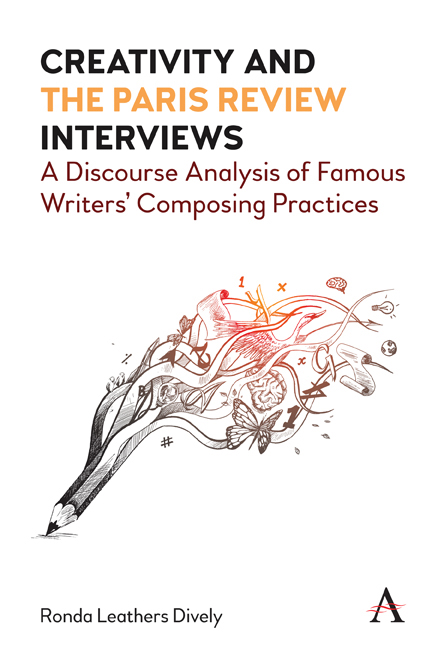 Creativity and 'the Paris Review' Interviews
Creativity and 'the Paris Review' Interviews Book contents
- Frontmatter
- Contents
- List of Illustrations
- Preface
- Acknowledgments
- 1 Impetus, Contexts and Methods
- 2 Composition through the Lens of Creativity Theory
- 3 First Insight, or the Glimmer of Possibility
- 4 Preparation, or Research Broadly Conceived
- 5 Incubation, or Breaks from Conscious Attention
- 6 Insight, or the Eureka Experience
- 7 Verification, or Evaluation
- 8 Emergent Patterns
- 9 Implications for Writing Instruction
- Appendix A Coding Table
- Appendix B List of Cited Paris Review Interviewees
- Appendix C Diagram of Analytical Categories, Subcategories and Themes
- References
- Index
3 - First Insight, or the Glimmer of Possibility
Published online by Cambridge University Press: 27 April 2022
- Frontmatter
- Contents
- List of Illustrations
- Preface
- Acknowledgments
- 1 Impetus, Contexts and Methods
- 2 Composition through the Lens of Creativity Theory
- 3 First Insight, or the Glimmer of Possibility
- 4 Preparation, or Research Broadly Conceived
- 5 Incubation, or Breaks from Conscious Attention
- 6 Insight, or the Eureka Experience
- 7 Verification, or Evaluation
- 8 Emergent Patterns
- 9 Implications for Writing Instruction
- Appendix A Coding Table
- Appendix B List of Cited Paris Review Interviewees
- Appendix C Diagram of Analytical Categories, Subcategories and Themes
- References
- Index
Summary
Arguably the most unnerving period of time in the professional life of any creative individual is the purgatory between projects, when the satisfaction of successfully responding to one artistic or scientific challenge is superseded by the call to get started on the next. The drive to answer this call can be intense, often inciting feelings of desperation as time progresses in the absence of promising, fresh concepts for new endeavors. Relief for this state of being, according to the paradigmatic creative process model, comes in the form of first insight, defined in earlier chapters as the initial glimmer of an idea that serves as a catalyst for innovation. Readers may remember from discussion of the paradigmatic creative process model in Chapter 2 that first insight and insight mimic each other to the extent that both serve as breakthrough moments. However, the former is distinguished by its status as the inception of a creative act and, as follows, by its comparatively underdeveloped nature. Put another way, while insight alleviates cognitive blocks that arise once work on an already formulated project is well underway, first insight alleviates cognitive blocks impeding the birth of a project.
Instances of first insight reported by fiction writers and poets in The Paris Review (PR) interviews sampled for this study depict a diversity of experiences, ranging from vague sensations that a revelation is imminent, to flashes of concrete starting points for focused reflection or investigation. The coding process for first insight ultimately yielded 125 references in accordance with the methodology outlined in Chapter 1 and the definition established in the previous paragraph. Although the aforementioned similarities between first insight and insight presented occasional difficulty in assigning textual units to one category over the other, multiple passes through the data reinforced the integrity of the coding scheme. In the end, textual units classified as first insight branched into four distinct subcategories: felt sense, cognitive dissonance, preference for certain literary elements and specific images. The number of subcategories reveals that first insight adopts various guises, an observation that is illustrated in the remainder of this chapter. Discussion of these findings begins with a subcategory characterizing first insight as a highly nebulous phenomenon and then moves through the other subcategories in an order that depicts the construct as increasingly well demarcated and capable of accurately foreshadowing the essence of a final product.
- Type
- Chapter
- Information
- Creativity and 'the Paris Review' InterviewsA Discourse Analysis of Famous Writers' Composing Practices, pp. 35 - 50Publisher: Anthem PressPrint publication year: 2022


